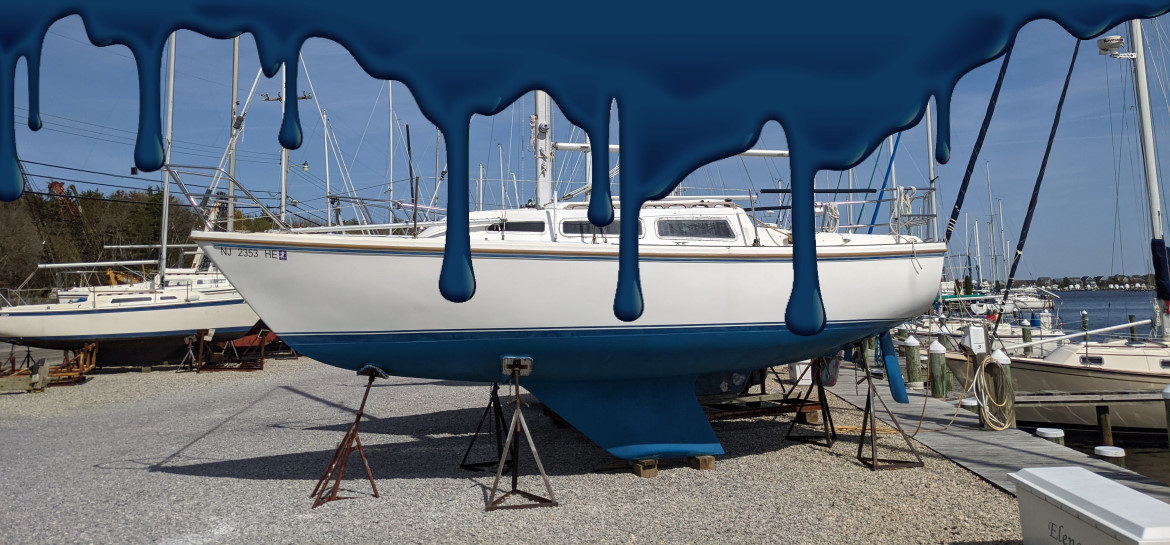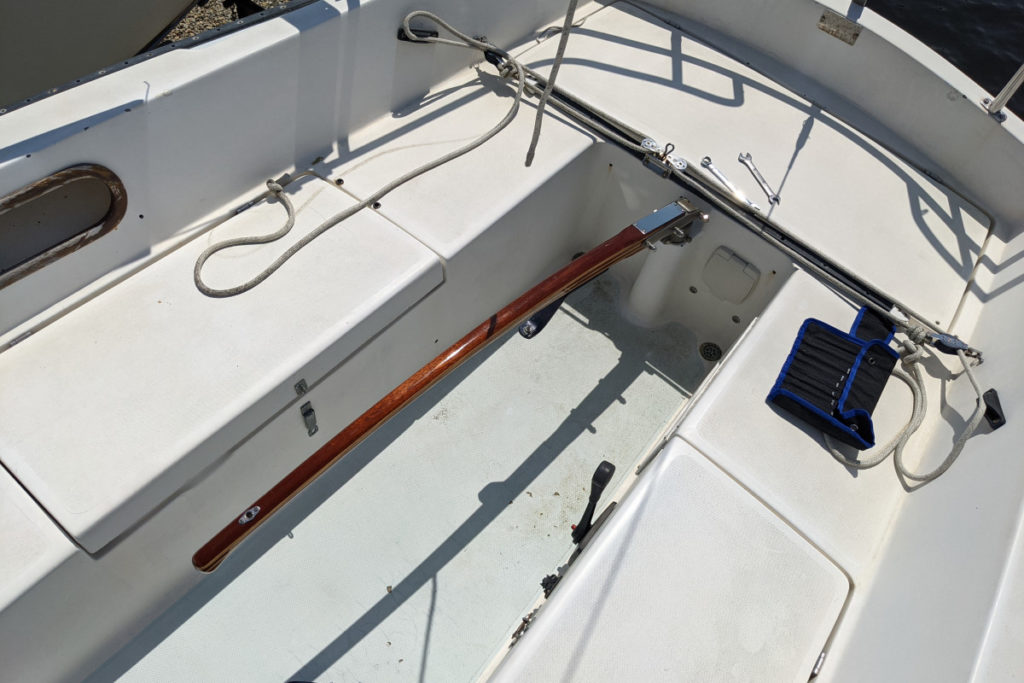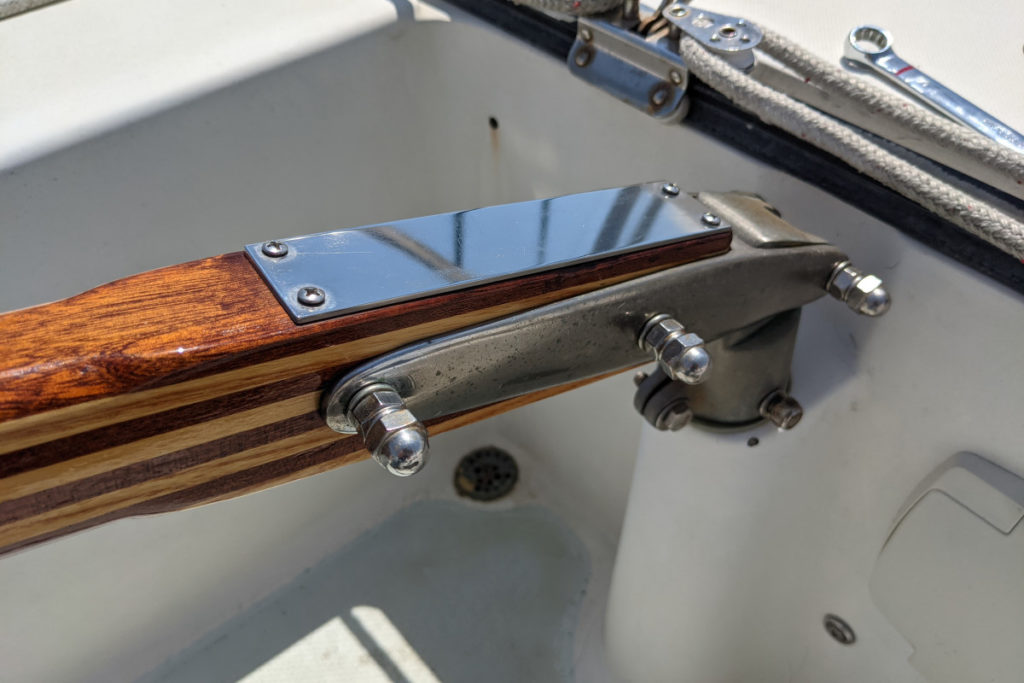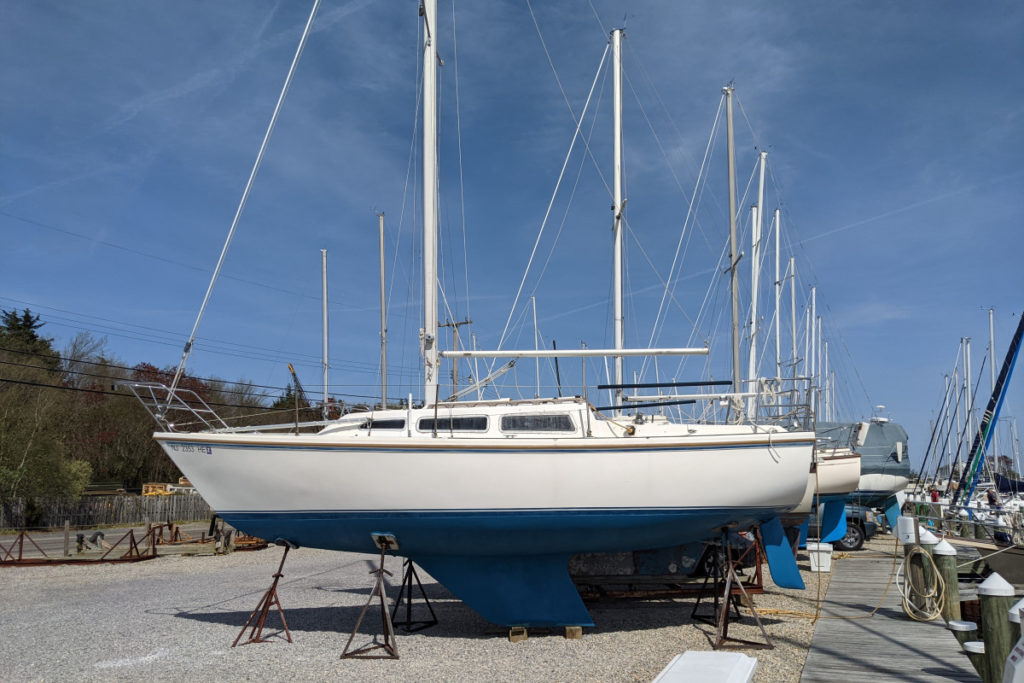
In my last log entry from April 6, I wrote that I could potentially paint the bottom of the boat and be in the water the following week. Sure, I hedged a little regarding the tiller varnish progress, but I still put it in there, I think mostly as sort of a personal challenge. As is often the case, I then said to myself, “Do not attempt to challenge me, sir!” and vanquished that unruly optimism. It is now May.
At this point, I have probably written about bottom painting too many times, but it’s an annual tradition, and is required to keep things from growing on the hull while the boat is in the water. I don’t particularly enjoy it, but I do enjoy sailing, and sometimes I have to catch the natural ebb and flow of those two ideas at the right moment to actually get it done.
This season, the delay was mostly because of the weekend weather. Rain is obviously problematic, and the paint isn’t supposed to be applied when it’s too cold. I don’t know why I get hung up about some of the painting instructions but not all of the painting instructions. I assume that the manufacturers want to give me the correct information so that the paint will perform well and I’ll buy more. I certainly go along with a lot of it, but there are also a few tidbits where I just think, “Well that’s not going to happen,” and it really isn’t even close. I am sometimes reminded of the time my dad showed me how to use the lawnmower: fill the gas; check the oil; set the throttle to “rabbit”; prime it; pull the cord until it starts; align the crusty, half-melted Wawa bag permanently tied to the handle to defeat the safety mechanism that would turn the engine off if I let go. It wasn’t even a consideration that the safety might have merit, and was such a strong lesson in “some of the world’s suggestions do not apply.”
Regarding the temperature requirements, I actually looked this up to make sure I hadn’t completely fabricated it as an excuse to avoid painting:
Remove all traces of loose paint by sanding the entire surface with 80 grit wet-or-dry sandpaper; wipe surface clean with Xylene using the two-rag method before and after sanding. Apply two coats of paint allowing for appropriate dry times. Do not apply when temperature is below 50°F / 10°C. Stir well before and during use.
I try to stir well. They have a shaker at the marina and that does most of the heavy lifting, and I usually have a stirrer on hand to keep mixing it during use (although, uh, I may have done a poor job of the in-progress stirring this year). I do wipe the surface, but I always feel like xylene is going to melt my face off and use naphtha instead. I have no idea what “the two-rag method” is—I assume some sort of wax on/wax off situation, but I have no chance of winning the All Valley Karate Tournament and just try to make sure that all of it gets touched to remove any egregious dust or oils. I don’t do two coats. I used to do two coats, but I felt like it was building up too much and getting flakey, so I’ve cut it back and it seems fine year over year. The one thing I treat with real reverence is the temperature. I don’t touch it below 50°F, or even if it’s going to get down below 50°F during the drying window. I prefer it to be over 60°F, and this year, by the time it stopped being 43°F, it was 80°F.
It was quite warm and also quite windy when Jenn and I got to the shore. The first order of business was to install the tiller, which I did eventually varnish. As I mentioned previously, I went with real Epifanes. In this instance, I honestly attempted to follow their instructions, but after several failed attempts and some discussion with other sailors who have many more gallons of tung oil under the bridge than I do, my general impression is that Epifanes is 2% science, 25% folk wisdom, and 73% patience. And on a good day, I can only muster like 18% patience. I eventually got the tiller to be somewhat reasonable looking and predominantly not tacky, and it is now in place.

I also got the steel plate installed that will hopefully protect the aft end of the tiller from getting dinged by the mainsheet block.

I needed to install the tiller so that when the boat gets launched, there will be a way to steer it. While I was up there, I also put some dock lines on so that there would be something to grab when getting into the slip, and I reconnected the batteries and plugged the boat in to charge them up. The only remaining pre-launch step was to prep and paint the bottom.
Of the tasks outlined in the official literature, the only one that I haven’t addressed is sanding. I have traditionally scuff sanded the old paint, as the instructions suggest. I don’t do the world’s most thorough job, but I feel like hitting the whole thing with 80 grit (and then wiping it off with a solvent) gives the new paint something to adhere to and keeps the flaking to a minimum. The sentiment around my marina seems to be that you just slap on some paint on and get the boat into the water, and I’ve had conversations where I’ve defended sanding it and felt good about doing it the “right” way. I always imagine not doing it the right way, pulling it out in the fall, and having it look like it came out of Wilford Brimley’s swimming pool in Cocoon. And then trying to apply more paint in the spring and the roller becoming more of a flake-removing machine rather than a paint-applying machine. So Jenn and I dutifully rolled out a drop cloth to catch the dust and got to sanding.
Then we were told to stop. The State of New Jersey has indicated to the marina that boaters can not follow the sanding guidance in the paint’s instructions. This is ablative paint, which is designed to abrade over the course of the season, but it is apparently forbidden to manually abrade it. The marina was apologetic, which wasn’t necessary—it wasn’t their fault, and I was apologetic for not complying. There had always been rules about collecting the dust and paint drips, and we were making our typical best effort at that (which is, admittedly, a farce when it’s blowing 20kts), but I didn’t realize that it was strictly no longer allowed.
Jenn wiped the boat down while I went to the store to get more tape to mask off the bootstripe. When I got back, we slapped some paint on. Jenn mostly handled keeping the paint tray full and in the right position while I operated the roller and whined about the location of the paint tray. In the spots that we didn’t sand, the roller seemed to be removing more paint than it was adding, much of which was redistributed via the paint’s [presumably poor] adhesive properties. I’ll have to work on my diabeetus pronunciation over the summer, because I’m pretty sure this is going to look like something that came out of Wilford Brimley’s pool by the fall.
Despite the limited sanding and a mix of industrial and medical PPE, we were still covered in blue dust. This happens every time. Steeped in blue dust, blue paint, and a sort of general body pain that comes from contorting below the hull in odd postures for hours, it seems like it should be a badge of honor, but I mostly just wanted to take a shower. We technically got it done though, and it looks fine from 40ft away.

We’re launching this week.